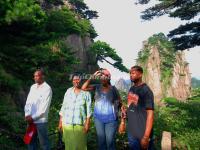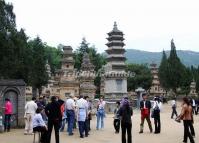Mount Siguniang
Mount Siguniang, aka "Four Girls Mountain" or "Four Sisters Mountain", named Skubla in Tibetan language, literally means "the mountains of the four girls". It is located in the bordering area of Xiaojin County and Wenchuan County in Ngawa Tibetan and Qiang Autonomous Prefecture, about 220 km from Chengdu, the capital city of Sichuan Province. It is the highest peak of the Qionglai Mountain ranges in Western China, adjacent to the Wolong Panda Reserve. Siguniang Mountains Scenic Area makes a name for herself for snow peaks, valleys, virgin forest and biology, and is extolled as the Queen of the Sichuan's Mountains. It also attracts scientists’ attention, and is an important part of Sichuan Giant Panda Sanctuaries, a site of UNESCO World Heritage.
Siguniang Mountain, covering area of 450 square km, was established as a national park in 1996 and in 2006 the Mount Siguniang National Park Administration Bureau was established to manage and conserve the landscape and biodiversity of this protected area. Mount Siguniang is one of China’s most popular sites for climbers and the majestic snow-capped peaks also make it a photographer’s delight.
Mount Siguniang consists of four continuous peaks: Da Feng (Big Peak or 1st peak), Er Feng (2nd peak), San Feng (3rd peak), and Yaomei Feng (4th peak), in a range of 3.5 km from north to south, rising at 5335m(17,503 feet), 5454m(17,894 feet), 5664m(18,583 feet), and 6250 meters(20,505 feet) above sea level respectively. Among them, the highest and the most beautiful peak is Yaomei Feng, literally "peak of the youngest sister", also known as the "Queen of Sichuan's peaks", standing at 6250 meters (20,505 feet). It is also the second highest mountain in Sichuan Province. The first ascent was in 1981 by a Japanese team via the East Ridge. Very few people attempt to climb this and very few of them succeed after that. Mt. Siguniang Da Feng, literally "peak of the oldest sister", is normally considered a pure trekking peak while Er Feng, literally "peak of the second sister", and San Feng literally "peak of the third sister", is more challenging as it involves basic climbing technique. The four peaks are covered with snow all year round, just like the four gracious girls wearing white gauze scarves.
From time immemorial it has been consecrated by the local Tibetan people. A legend has it that many years ago, there lived a mountain god named Balang who had four beautiful daughters, and the youngest was the tallest and had the most graceful figure. A devil admired the girls' beauty and wanted to marry them. So the devil suggested to the mountain god that they fight a duel. If he won, he would get the four girls. The mountain god was killed by the devil. And the four girls fled and eventually died from cold weather. Their bodies became the Siguniang Mountains and their father became the Balang Mountain. But another tale holds that the four girls were saved by a hunter and became fairies. The Siguniang Mountains resemble four graceful fairies wearing white mantles and waving to guests from afar. They stand shoulder by shoulder plunging their heads into the clouds, with glaciers wrapping around their shoulders and green forests around their waists.
Siguniang Mountain is famous for its beautiful scenery. It is reputed to be the "Oriental Alps". Siguniang Mountains Scenic Area consists of Shuangqiao Valley, Changping Valley, Haizi Valley and the Siguniang Mountains themselves.
Changping Valley (Changpinggou)
Changping Valley (Long-Peace Valle) mainly consists of forests, valleys and snowy mountains towering over valleys. Changping Valley is the favorite valley for tourists, because you can really get involved with nature. One of the Siguniang Mountains lies 16 km inside the valley. And only part of the road is open to traffic and the rest are only suitable for people to walk or ride horses. The way from the Changping Valley to the Siguniang Mountains is very narrow and winding. Coniferous forest, broadleaf forest, sub-forests, shrub wood and weed clusters joggle together and exhibit their contrasting charms.
In Changping Valley, there are scores of ancient cypresses, lama monasteries, waterfalls of meters high. When you cross Changping Valley hiking or riding on horses, pass through original forests, bestride brooks, and surmount the snow-covered mountains, you can eventually camp after a trip of six or seven hours. There is a horse renting house at the Lama Temple, and the price is 50 to 200yuan a day. When it is the busy season of touring the price will rise.
Exploring Changping Valley requires a whole day, and there are no restaurants, so you must bring your own food and supplies into the valley with you.
Shuangqiao Valley (Shuangqiaogou)
In Shuangqiao (Double Bridge) Valley, two famous wooden bridges were built there, hence the name. The valley is at an elevation of 3,840 m, measures about 34.8 km. It includes 17 sightseeing points and 54 scenic spots. This valley, like the Changping Valley, is a mountain sanctuary rivaled nowhere else in Aba. It is the most easily accessible place to view snowy peaks, pastures, grassland and forests. It is the most beautiful valley of Mt. Siguniang. With three sections covering an area of 216.6 square kilometers, the whole valley is accessible by tour bus. It's the easiest and quickest way to see the valley because of the amount of distance and the ruggedness of the terrain.
The first section contains some unique sights including Willow (Yangliu) Bridge, Yinyang Valley, the White Poplar Zone, Sun-Moon Mirror Mountain (altitude15, 747 feet) and Five Colors (Wuse) Mountain (altitude14, 673 feet). Yinyang Valley extends 2 kilometers, and occupies the area near the entrance to Willow (Yangliu) Bridge. Out of the narrow ravine and steep cliffs a brook flows quietly. Entering the valley, the bright sunshine is suddenly disappears. If you raise your head and look up, you can only see a sliver of sky. The Sun-Moon Treasured Mirror Mountain stands next to the Five Colors Mountain. A huge rectangular boulder split in two on the snow-capped mountaintop looks like two bright mirrors hanging over the horizon. Five Color Mountain is the most spectacular sight in Shuangqiao Valley. The mountain is made from five colors of rock: red, yellow, green, blue and white. In the middle section is the Driven Fish (Nianyuba) Plank Road built along a cliff and the Shaji woods (Shahulin). Shaji is a small golden fruit, which is called the 'King of vitamin C'. In the last section are marvelous rock sculptures carved naturally by the wind. You can see wonderful shapes resembling an ape, a hunter, or a hawk beak. More than ten snowcapped mountains above 4,000 meters make the area a favorite with climbers.
Haizi Valley (Haizigou)
Haizi Valley (Alpine-Lake Valley) has a total length of 19.2km, covers an area of 126.48 square kilometers. The valley is named after the numerous alpine lakes it contains, including Flower Alpine-lake (Haizi), White Alpine-Lake (Haizi), Blue Alpine-Lake (Haizi) and Yellow Alpine-Lake (Haizi). One of the lakes, Flower Alpine-Lake (Haizi), was formed by glacial seepage during the 4th century. Visiting this valley is for people who have experience in mountaineering and exploration. The beautiful surrounding mountains are reflected in the lakes where the non-squama Yunguyu (a type of primitive fish), the living fossil of this land, can still be found.
It is interesting that the boulders scattered along the lakes, look like swan eggs from a distance. Most of the lakes are 4,200 meters (about 13,650 feet) above sea level, so only a few tourists have visited them. But the few who have say that their beauty is staggering. There is no road for car in Haizi Gully but only cragged paths, and you can either walk or ride a horse. If you are a true lover of wilderness, Alpine-Lake (Haizi) Valley is definitely worth a visit.












